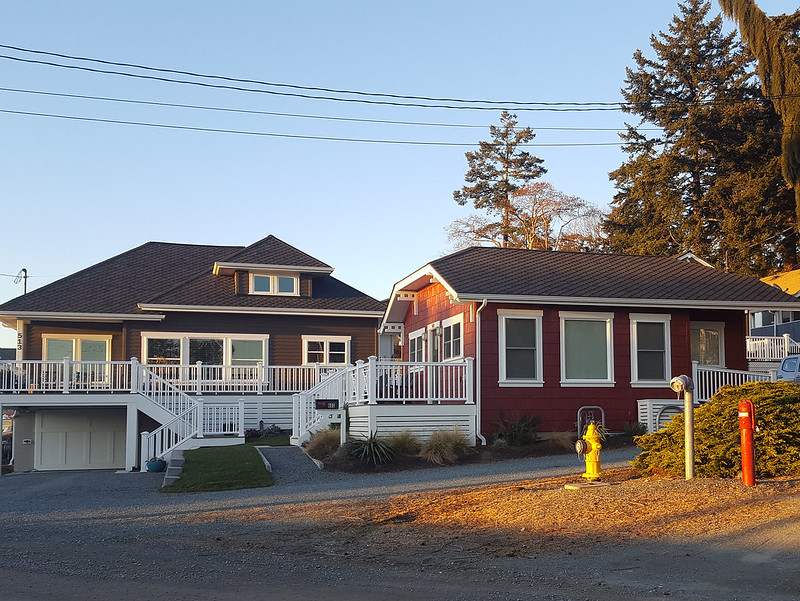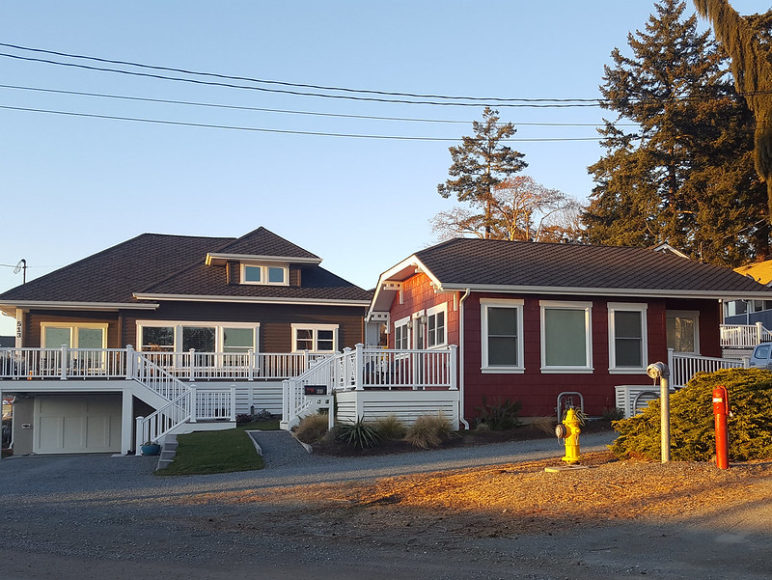Washington state representatives Mia Gregerson (D-SeaTac) and Andrew Barkis (R-Olympia) introduced a new bill in Olympia yesterday evening that would lift barriers to backyard cottages and mother-in-law apartments across the state. And it probably looks familiar.
These modest homes—which urban planners call accessory dwelling units (ADUs)—provide low-impact infill housing options in existing neighborhoods, cutting commutes and increasing access to parks, schools, shops, and transit. Their flexible design and smaller size makes them suitable for a variety of households, from aging parents to fledgling graduates.
If passed, the bill would dismantle five top barriers homeowners face to building ADUs on their property:
- Remove lot size requirements for attached ADUs, and set 3,500 square feet as the standard lot size minimum for detached units;
- Eliminate off-street parking and owner occupancy requirements;
- Limit permitting, plan review, and impact fees to no more than half of those applied to single, detached residences;
- Require new utility connections only when site-specific conditions warrant a second connection, and ensure fees are proportionate to the burden the secondary units place on the water or sewer system.
The bill also establishes a menu of five additional reforms, of which jurisdictions must implement at least three. Options include permitting two ADUs per parcel, allowing more generous size and height limits, and adopting preapproved ADU architectural plans. The menu framework gives cities flexibility to select policies that fit local contexts, while ensuring all jurisdictions take meaningful action to boost ADU production.
The third section of the bill includes a list of additional policy recommendations, including eliminating impact fees, and upping rear yard coverage standards. The bill encourages, but does not require, adoption of these policies.
The bill—which Sightline advised on—would go into effect in July 2021, and apply only in jurisdictions planning under the state’s Growth Management Act that exceed specific population thresholds: 2,500 for cities, and 15,000 for counties. These jurisdictions would also be exempt from appeals under the state’s Environmental Protection Act (SEPA) for any policy implemented under the bill. Despite established climate benefits of infill housing, activists frequently file SEPA appeals to block green urban planning initiatives.
Last year’s effort to cut ADU red tape across Washington garnered support from lawmakers on both sides of the aisle, as well as from affordable housing and environmental advocates. Despite its popularity among diverse stakeholders, the 2019 bill failed to pass. Legislators concerned that the bill destroyed local autonomy gutted the proposal. This year’s more flexible design responds to concerns about locally specific solutions, while ensuring all cities take meaningful action on ADUs.
Since Washington legislators stalled on last year’s bill, California and Oregon have moved forward with their own statewide ADU reforms, and cities in both states are already reaping the benefits.
Given the urgency of the state’s housing shortage, and the broader climate crisis, Washington legislators would be remiss to delay action on a bill that would provide much needed progress on both.










Steve Erickson
I just read the current version of the bill. Its pretty clear that its restricted to incorporated areas and UGAs. As long as that isn’t removed during the sausage making . . .
Teri Massengale
Thanks for the chuckle, I enjoyed the “sausage” comment.
David Fisher
If local politicians can get there finger in creating – complicating ADU regulations you can bet they will! Local voters don’t want more people, more density in their cities. They want to protect things the way they are. They vote for local politicians who agree with them.
Ruth Williams
I am unclear about where conservation of existing resources fits into today’s urban sustainability programs. I never see it mentioned. Doesn’t true sustainability recommend keeping the buildings we have, but adapting them to meet today’s needs?
This would mean pushing attached ADUs and losing the detached ones in order to use fewer resources, keep utility bills down, and keep more of the yard and trees.
Amy L Turnbull
While I applaud legislation to promote new models for housing, what is always lacking is financing: legislation needs to include incentives to promote ADU development. After years of supporting ADU advocacy, I have begun to realize that ADUs are the domain of those who already hold property and have money and or/equity. However, with building costs averaging $300 per square foot and a little thing called ROI (return on investment), homeowners who build ADUs may not be able to supply them at or below affordable rents. Hence, ADUs may not provide the relief we are looking for to provide substantial affordable housing units unless legislation also provides incentives as part of their legislative packet. Of course, that would create further resistance from NIMBYs (not in my backyard) who fiercely protect their single family zoning. My point is ADUs are not all they are cracked up to be in supplying much-needed housing because they are too expensive to build. NIMBYs can rest assured their neighborhoods will remain the territory of privilege unless legislative language also includes financial incentives to promote their development.
Kathy Johnson
I have been trying to build a DADU – the biggest impediment – cost. Banks will not finance their construction other than a straight remodel. With the cost running $300 – $600K to build, it forces the homeowner to gamble all of its equity on a cash out refi to build. Since there is no history as a source of income, they are not considered investment property. If the state / cities are really serious, there has to be no or low cost financing available.
Michael Sweazey
I wish there was a way to get the focus off the “accessory” dwelling and put more focus into the backyard cottage as an independent dwelling option for our young, elderly, caregiver, low-income neighbors and the like. More important should be disclosing the ability to condo out these detached backyard cottage projects so that these smaller homes could be purchased as stand-alone affordable homes.
If we use $300.00 per square foot for building cost, a new 1,200 S/F 2-bedroom backyard cottage would cost $360,000.00 Now this is where I get excited. Let’s pause and take a look at look at this for a moment.
If you Google the MLS ONLINE and search the City of Shoreline’s single-family listing you will see $400K will get you a teardown and $500K will get you a home built in 1930, 1940 and 1950 needing plenty of updates.
If Builders/Developers could build these smaller cottage homes and sell them for $550K+/- they would realize a $100K return on their investment after construction, holding, closing costs are all inputted. There would be a long line of pride of ownership personal wanting to get their hands on one of these brand-new cottage homes as independent living without shared apartment walls.
20% down payments would provide mortgage payments below local rental rates for the same size home costing $1,800.00 per month. Can you see why so many would get excited!?!?
Yes, the pride of ownership is the American Dream!!!
I would be very proud to be part of this movement!
I submitted a Development Code Amendment at the City of Shoreline late 2018 that I am told will be up for discussion on May 21, 2020, at the planning commissions 7 PM meeting. My proposal is for all residential lots within the City of Shoreline greater than 10,000 S/F would be allowed to build these backyard type of cottages if they remain single-story homes only. Lots eligible would be around 1,600 which represents 11% to 12% of the total housing stock in Shoreline. No owner occupancy, no size restrictions, reduced impact fees, no limits on selling the property and I am ok with providing off-street parking on lots of this size. Time will tell if the City of Shoreline council members will take lead on this issue and put forth something that will bear fruit.
Contact Senior Planner Steve Szafran at the City of Shoreline if you support my proposal. sszafran@shorelinewa.gov
Peter Streiling
Hello, I’m a Canadian and we are Building ADU’s pre fab starting at $99k usd. This is for 200sft. 10×20. Then the sizes go up 400,600… have a look at our website: http://hewinghaus.com/
We are located just across the border in Abbotsford BC.